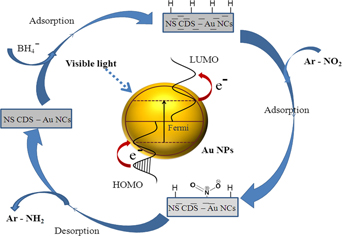Cover: TEM image of the nanoparticles obtained using the standard protocol except for the introduction of different amounts of CF3COOAg. [M. Zhao, X. Yang, Z. Hood, M. Chi, Y. Xia: Facile synthesis of Pt-Ag octahedral and tetrahedral nanocrystals with enhanced activity and durability toward methanol oxidation. p. 3891].
Invited Feature Paper
Facile synthesis of Pt–Ag octahedral and tetrahedral nanocrystals with enhanced activity and durability toward methanol oxidation
-
- Published online by Cambridge University Press:
- 08 October 2018, pp. 3891-3897
-
- Article
- Export citation
Article
Adsorptive removal of phenol by single and double network composite hydrogels based on hydroxypropyl cellulose and graphene oxide
-
- Published online by Cambridge University Press:
- 23 October 2018, pp. 3898-3905
-
- Article
- Export citation
N, S doped carbon dots—Plasmonic Au nanocomposites for visible-light photocatalytic reduction of nitroaromatics
-
- Published online by Cambridge University Press:
- 26 September 2018, pp. 3906-3916
-
- Article
- Export citation
Simultaneous morphology, band structure, and defect optimization of graphitic carbon nitride microsphere by the precursor concentration to boost photocatalytic activity
-
- Published online by Cambridge University Press:
- 04 October 2018, pp. 3917-3927
-
- Article
- Export citation
Fabrication of Bi2MoO6/BiOI heterojunction photocatalysts for enhanced photodegradation of RhB
-
- Published online by Cambridge University Press:
- 12 October 2018, pp. 3928-3935
-
- Article
- Export citation
In situ synthesis of CsTi2NbO7@g-C3N4 core–shell heterojunction with excellent electrocatalytic performance for the detection of nitrite
-
- Published online by Cambridge University Press:
- 12 October 2018, pp. 3936-3945
-
- Article
- Export citation
Green synthesis of functionalized graphene and their use as solid acid catalysts
-
- Published online by Cambridge University Press:
- 22 October 2018, pp. 3946-3952
-
- Article
- Export citation
Preparation and photocatalytic application of AgBr modified Bi2WO6 nanosheets with high adsorption capacity
-
- Published online by Cambridge University Press:
- 06 November 2018, pp. 3953-3962
-
- Article
- Export citation
Tunable blue-green emission from ZnS(Ag) nanostructures grown by hydrothermal synthesis
-
- Published online by Cambridge University Press:
- 05 November 2018, pp. 3963-3970
-
- Article
- Export citation
Combustion synthesis and photoelectrochemical characterization of gallium zinc oxynitrides
-
- Published online by Cambridge University Press:
- 06 November 2018, pp. 3971-3978
-
- Article
- Export citation
Differential scanning calorimetric measurements and thermodynamic functions of YbRhO3(s)
-
- Published online by Cambridge University Press:
- 31 October 2018, pp. 3979-3985
-
- Article
- Export citation
Invited Feature Paper - REVIEW
Atomistic consideration of earth-abundant chalcogenide materials for photovoltaics: Kesterite and beyond
-
- Published online by Cambridge University Press:
- 12 October 2018, pp. 3986-3998
-
- Article
- Export citation
Article
High photoresponsivity and light-induced carrier conversion in RGO/TSCuPc hybrid phototransistors
-
- Published online by Cambridge University Press:
- 18 October 2018, pp. 3999-4006
-
- Article
- Export citation
Invited Feature Paper
Integrated ferroics for sensing, power, RF, and µ-wave electronics
-
- Published online by Cambridge University Press:
- 12 October 2018, pp. 4007-4017
-
- Article
- Export citation
Interfaces and defect composition at the near-atomic scale through atom probe tomography investigations
-
- Published online by Cambridge University Press:
- 06 November 2018, pp. 4018-4030
-
- Article
-
- You have access
- Open access
- HTML
- Export citation
Invited Paper
Laser additive manufacturing of powdered bismuth telluride
-
- Published online by Cambridge University Press:
- 06 November 2018, pp. 4031-4039
-
- Article
- Export citation
Article
Microstructure evolution and thermal properties of an additively manufactured, solution treatable AlSi10Mg part
-
- Published online by Cambridge University Press:
- 06 November 2018, pp. 4040-4052
-
- Article
-
- You have access
- Open access
- HTML
- Export citation
Temperature and DC bias dependence of the phase transition behavior of [011]- and [001]-oriented PIN–PMN–PT single crystals with MPB composition
-
- Published online by Cambridge University Press:
- 18 October 2018, pp. 4053-4061
-
- Article
- Export citation
Low-temperature synthesis and microwave absorbing properties of Mn3O4–graphene nanocomposite
-
- Published online by Cambridge University Press:
- 17 September 2018, pp. 4062-4070
-
- Article
- Export citation
Correlation between vibrational modes, crystal structures, and dielectric properties of (1 − x)Ba(Mg1/3Ta2/3)O3–xBa(Co1/3Nb2/3)O3 ceramics
-
- Published online by Cambridge University Press:
- 06 August 2018, pp. 4071-4079
-
- Article
- Export citation




























